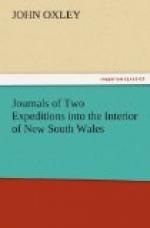June 28.—Remained here this day for the purpose of rest and refreshment: the grass and country poor, and covered with acacia trees and small eucalypti in our immediate vicinity. Despatched two men to view the country to the north-east. The botanical collector crossed the river and ascended Mount Forster, on which he was fortunate enough to procure many plants seemingly new: he thought he saw a branch of the river separating from it and running to the north-west, whilst the river itself continued to go northerly. The account brought by the men in the evening was far from flattering; they had been out ten or twelve miles to the north and east, and found the country as bad as can be imagined; in fact, a dry morass, with higher land, free from floods, but overrun with brushes, among which a few pines were scattered: they saw no water, and but little game of any kind.
June 29.—As we proceeded down the river, the country gradually became much lower in its immediate vicinity; and between four and five miles from our resting-place it was even with the banks, and in some places overflowed them. All travelling near the river with horses was at once interrupted, and this was the more perplexing as it rendered the communication with the boats uncertain, and liable to be cut off altogether. Finding that those marshes were only impassable for a mile or little more from the river, and that occasionally we could approach within one hundred yards of it, the horses were directed to keep round the edge of them, making for the river whenever practicable, and firing guns to let the boats know our situation. At two o’clock in the after. noon we stopped, after going about ten miles and a half, about one hundred and fifty yards from the river. which we could not approach nearer by reason of wet and boggy marshes; in fact, the place where we stopped




